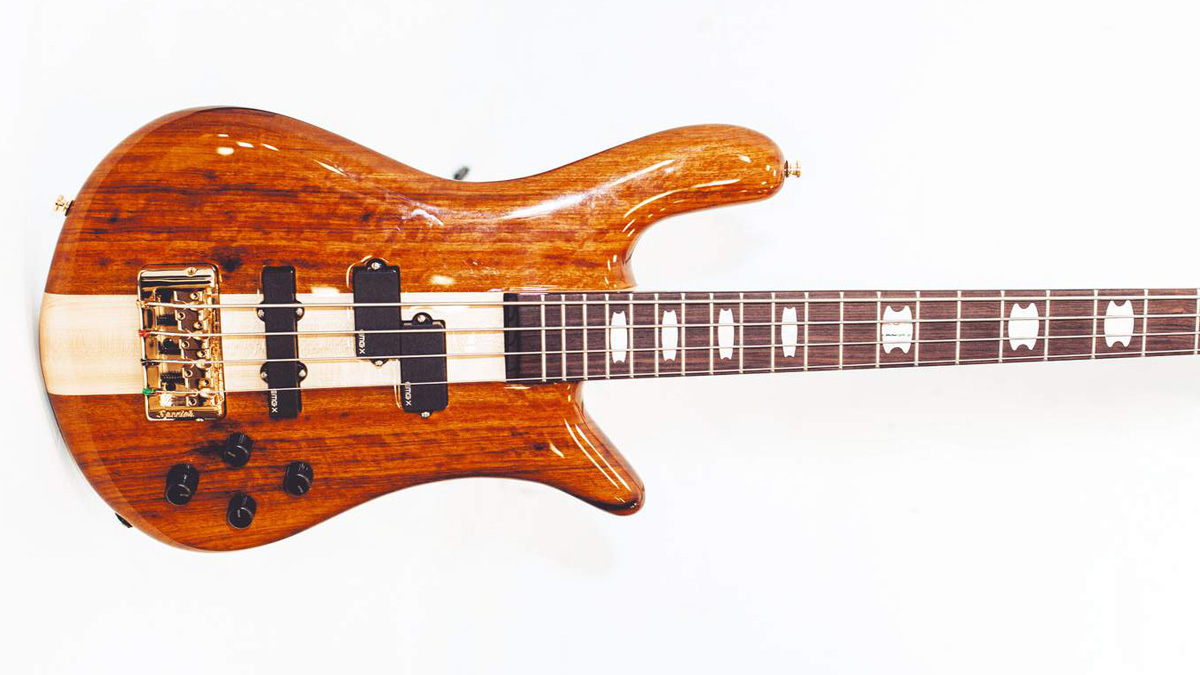MusicRadar Verdict
Another winner from Spector; a fine bass in all respects.
Pros
- +
Luscious visuals, wide tone range, excellent playability.
Cons
- -
Pricey - and that G string issue may be annoying.
MusicRadar's got your back
It’s not often that a manufacturer produces a UK-specific model, but here we have one of the new koa-topped Euro LX basses, also available in a five-string format with split-coil pickups in humbucker pickup housings and a matte finish.
We’ve been consistently impressed with the Spector ranges in recent years, so we were rubbing our hands with glee at the chance to find out how this naturally-finished four-string compares.
Build
Visually, the koa model harks back to some of the original bubinga and walnut beauties that helped to make Spector’s name in the brand’s early years. Its rich dark body wings flank a three-piece, maple through-neck. The grain of the koa timbers stands out nicely underneath the highly polished gloss finish. Flip the bass over and the cream tones of the alder body core, with a rosewood veneer laminate, fit perfectly with the maple colouring.
The signature body curves and contouring offer a comfortable playing experience, while the extensive cutaways provide unhindered access to the full 24 frets of the dark rosewood fingerboard.
The gloss finish runs the full length of the bass, which gives the maple neck some added protection. The gold-coloured brass nut, locking bridge and Gotoh machine heads add a bit of unashamed bling to the bass’s looks, while the mother-of-pearl crown inlays leave you in no doubt that you are playing a Spector. White side dots have been used along the side of the neck, so all the visual cues you need to jump around the fretboard with confidence and accuracy are in place. Overall, this is a very nicely constructed instrument. We’d expect nothing less of the Spector brand, regardless of whether it is a Euro or a US model.
Although there is some headstock bias, the bass balances well on a strap, falling naturally into a very comfortable playing position. The rounded neck profile complements the slim nut width, presenting the player with a solid-feeling neck that nestles snugly into the fretting hand. The EMG X P/J pickup configuration is backed up by a 9-volt Aguilar OBP-3 circuit, comprising volume, pickup pan, stacked bass and treble and a mid control with push/pull activation for frequency (400/800 Hz) selection.
Sounds
Essentially, the Euro4 LX has always been a finely crafted alternative to the full-blown NS2, and when you put it to use it’s clear that the koa model is carrying on that tradition with aplomb. Even before you plug it in, it exhibits a clear, throaty growl. Playing any of the strings provides evidence, were it needed, that the bass means business. The piano-like sustain rings out, and you can clearly feel the bass resonate as you play it.
Using an Aguilar AG700 amp and SL212 cabinet, plugging in immediately unleashes the Euro4’s potential. All of the instrument’s unplugged characteristics are apparent in the full, rich, complex tone that comes to the fore. Although the Aguilar circuit doesn’t take your head off in the same way that the TonePump circuit of old did, the sheer force on offer is nonetheless exceptional. So, brute force but not ignorance; the circuit has the ability to smooth off the rougher edges if you require a little more refinement. Panning between both pickups clearly shows the unique qualities you would expect from each unit, based on their design and location, and the EQ is sensible without being extreme.
Spector instruments were once considered solely the property of rock and metal bassists, but times have changed; this bass represents a far more flexible package that could see use in a much greater variety of settings. Slappers and tappers in particular will enjoy its stand-out percussive qualities. Rock players, of course, will already be well aware of the instrument’s capabilities. If a full, rounded low end is your preference, this bass delivers it.
Stuart Spector has always addressed the playability of his instruments, and from the 3-D contoured body to the slinky feel of the neck, as well as the easy fretting, top-notch setup and the responsive output, this bass will keep you coming back. The only tiny negative is that the G string is precariously close to the edge of the fingerboard; you’ll need to adjust your technique accordingly.
This is a seriously enjoyable bass, and very versatile in all departments. It should appeal to many players, regardless of musical genre. If you’re on the lookout for a new bass squeeze, you’d be well advised to check one of these out before they get snapped up.
““We were arguing a lot and we were miserable”: How Green Day exceeded expectations with their most ambitious song
"There’s plenty for us guitarists to learn – and ‘less is more’ is the overriding lesson": how to play like George Harrison on The Beatles' Abbey Road
“They didn’t like Prince’s bikini underwear”: Prince’s support sets for the The Rolling Stones in 1981 are remembered as disastrous, but guitarist Dez Dickerson says that the the crowd reaction wasn’t as bad as people think










